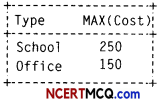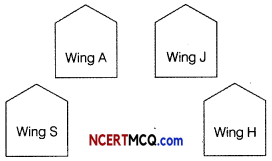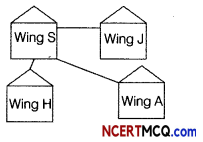Students can access the CBSE Sample Papers for Class 12 Informatics Practices with Solutions and marking scheme Term 2 Set 9 will help students in understanding the difficulty level of the exam.
CBSE Sample Papers for Class 12 Informatics Practices Term 2 Set 9 with Solutions
Maximum Marks : 35
Time : 2 hours
Instructions:
- The question paper is divided into 3 sections – A, B and C.
- Section A, consists of 7 questions (1-7). Each question carries 2 marks.
- Section B, consists of 3 questions (8-10). Each question carries 3 marks.
- Section C, consists of 3 questions (11-13). Each question carries 4 marks.
- Internal choices have been given for question numbers -1, 3, 8 and 12.
Section – A
(Each question carries 2 Marks)
Question 1.
M/s Agra Garments was lacking some enhanced network devices as they were not quite conversant about the devices and their uses. Explain the following devices and their uses to them.
(i) Gateway
(ii) Router
Or
Expand the following terms.
(i) ARPANET
(ii) ISP
(iii) URL
(iv) XML
Answer:
(i) A gateway is a network node used in telecommunications that connects two networks with different transmission protocols together. Gateways serve as an entry and exit point for a network as all data must pass through or communicate with the gateway prior to being routed. Ih most IP-based networks, the only traffic that does not go through atleast one gateway is traffic flowing among nodes on the same Local Area Network (LAN) segment. The term default gateway or network gateway may also be used to describe the same concept.
(ii) A router is a computer whose software and hardware are designed to move data between computer networks. This is the first device your computer will connect to in order to get to the Internet. It is also known as a default gateway (because it is your gateway to the Internet).
A router is a switching device for networks, which is able to route network packets, based on their addresses, to other networks or devices. Among other things, they are used for Internet access, for coupling networks or for connecting branch offices to a central office via VPN (Virtual Private Network).
Or
(i) ARPANET stands for Advanced Research Projects Agency NETwork.
(ii) ISP stands for Internet Service Provider.
(iii) URL stands for Uniform Resource Locator.
(iv) XML stands for extensible Markup Language.
Question 2.
(i) Antariksh was explained about different types of networks by his teacher, but he was curious about the range upto which they work. Explain him the ranges of the following network types.
(a) LAN
(b) MAN
Answer:
(a) LAN Local Area Networks are constructed for small geographical areas within the range of 1-5 km such as offices, schools, colleges, small industries or a cluster of buildings.
(b) MAN Meteropolitan Area Neworks typically cover transmission ranges between 5 and 10 km in diameter and may cover an area, the size of a city, or even a group of small buildings. MANs often act as a high speed network that allows sharing of regional resources and also provide a shared connection to other networks.
(ii) While procuring various network devices for her company, Snehlata was confused, whether she would need the following devices. Help her with the uses of the following devices.
(a) Modem
(b) Hub
Answer:
(a) Modem is short for “MOdulator-DEModulator”. It is a hardware component that allows a computer or another device, such as a router or switch, to connect to the Internet. It converts or “modulates” an analog signal from a telephone or cable wire to digital data (Is and Os) that a computer can recognise and digital signal to analog.
(b) Hub is commonly used to connect segments of a LAN (Local Area Network). A hub contains multiple ports. When a packet arrives at one port, it is copied to the other ports so that all segments of the LAN can see all packets. Hub acts as a common connection point for devices in a network.
![]()
Question 3.
Shankar understands the working of following functions but wants to have one example command using each of the following functions. Suggest him examples,
(i) ROUND()
(ii) NOW()
Or
Ravi was told by her teacher to write two example commands using SQL functions. Help him in the work.
(i) TRAILING clause with TRIM()
(ii) DAY()
Answer:
(i) The ROUND() function rounds a number to certain decimal places,
e.g.
SELECT ROUND(189.969,2);
Output:

(ii) NOW( ) returns the current date and time in the format ‘YYYY-MM-.DD HH : MM: SS’ or YYYYMMDDHHMMSS format.
e.g.
SELECT NOW();
Output:

Or
(i) TRAILING clause with TRIM( ) function indicates only the trailing suffixes are to be removed.
e.g.
SELECT TRJM(TRAILING '!' FROM’’ '!!!! India !!!!’):
Output:

(ii) DAY () function returns the day of the month (from ito 31) from a date specified as an argument.
e.g.
SELECT DAY (2021-09-30);
Output:

Question 4.
While learning web development, Manpreet came across the following terms and could not well differentiate among them. Explain her the following terms.
(i) Web server
Answer:
Web server A web server is a computer that runs websites. It’s a computer program that distributes web pages as they are requisitioned.
The basic objective of the web server is to store, process and deliver web pages to the users. This intercommunication is done using HyperText Transfer Protocol (HTTP).
(ii) Web page
Answer:
Web page A web page is a simple document display able by a browser. Such documents are written in the HTML language. A web page can embed a variety of different types of resources such as: style information — controlling a page’s look-and-feel.
A web page is a way to display information on the Internet. It’s made up of elements like text, images, links, videos or buttons.
![]()
Question 5.
Jitendra wrote the following SQL statements but was not understanding exactly what outputs they would produce? Help him in finding the outputs.
(i) SELECT M0D(R0UND(122.2,0), 10);
Answer:

ROUND(122.2,0) rounds the number to 122 and MOD(122,10) returns the remainder of division that is 2.
(ii) SELECT POW(2,-3);
Answer:

POW (2, -3) returns 2-3 = 0.125
Question 6.
Rajan was trying to find certain groups among the records of a sports table comprising of sportsman details. He also wanted to filter certain groups. Which clause, he has to use? Also, explain him the use of the clause.
Answer:
He has to use the HAVING clause along with GROUP BY. Just as the WHERE clause filters individual records on certain conditions, the having clause can be used to filter certain groups from the output on the basis of conditions on grouped values.
Question 7.
While trying to produce outputs using some SQL commands, Mr. Sagar could not get the results. Help him with the proper functions for the following cases.
Table: Furniture
![]()
(i) SELECT SEARCH(Fname,“aa”) FROM Furniture;
To search for the position of “aa” in the Fname column.
(ii) SELECT ADD(Price) FROM Furniture;
To get sum of all the prices.
Or
(i) SELECT MERGE( Fname,Type) FROM Furniture;
To display the Fname and Type concatenated.
(ii) SELECT SQUARE( Price, 2) FROM Furniture;
To display the square of the prices.
Answer:
(i) iNSTR()
(ii) SUM()
Or
(i) CONCAT()
(ii) POW()
Section – B
(Each question carries 3 Marks)
Question 8.
Ms. Rajeshwari was not quite comfortable understanding the following SQL statements. Help her with alternate statements that would produce same outputs.
(i) SELECT DAY (“2019-08-12”);
(ii) SELECT MONTH ( “2020-07-06”);
(iii) SELECT YEAR(“2016-07-12”) ; ‘
Or
Rana was instructued by his teacher to write any three date/time functions with their description and an example of each. But he is not comfortable with DATE()/TIME() functions. Help him in the assignment.
Answer:
(i) SELECT RIGHT(”2019-08-12”.2);
(ii) SELECT MID(”2020-07-06”.62);
(iii) SELECT LEFT(”2016-07-12”,0,4);
Or
(i) MONTH() This function returns the MONTH part from the date argument within a range 1 to 12 (January to December() and it returns 0 if MONTH part of the date contains null,
e.g.
SELECT MONTH ( ‘ 2014-12-01’);
Output:

(ii) DAYNAME() It returns the name of the week day from a date sepecified as an argument.
e.g.
SELECT DAYNAME( ‘ 2021 -11 - 20 ’ ) ;
Output

(iii) YEAR() This function returns the YEAR part from the given date argument. The return value is in the range of 1000 to 9999 or 0 for null date.
e.g.
SELECT YEAR(‘2015-01-01’);
Output:

![]()
Question 9.
Sambudhha a database learner came to know that certain MySQL functions and statements can be written alternatively. Suggest him ways to write the following statemets in an alternative way.
(i) SELECT SUB ST R ( ‘ Concavemirror ’, 1,3);
Answer:
SELECT LEFT( “Conca vemi rror” , 3);
(ii) SELECT MOD(11,5);
Answer:
SELECT 11%5;
(iii) SELECT RIGHT(‘ Gymnastics ’ , 5);
Answer:
SELECT MID(“Gymnastics”,6, 5);
Question 10.
Srikant was not sure about the parameters required for some of the MySQL functions. Help him with the parameters of the following functions.
What parameters do the following SQL functions need for execution?
(i) INSTR()
Answer:
INSTR (String 1, String 2)
Here, String 1 is the string to be searched and String 2 is the string to be searched from String 1.
(ii) SUBSTR()
Answer:
SUBSTR (String 1, pos, len)
Here, String 1 is a string from which a sub-string is returned, pos is an integer indicating the string position and len is an integer indicating the length of the sub-string.
(iii) MOD()
Answer:
MOD (Dividend, Divisor)
Here, Dividend is the number whose division remainder is required and Divisor is the number by which to divide to get the remainder.
Section – C
(Each question carries 4 Marks)
Question 11.
Mr. Ritesh is a sports coach and maintains the inventory of sports items of his college. The Inventory table and its structure with a sample record is given below. He wants to produce certain outputs from the table in certain formats as required by the college, for which he needs to use the MySQL functions. Help him to answer the questions given below with appropriate function names and queries.
Table: Inventory

Write proper statements that will be required for the following cases.
(i) To find the average reorderlevel among inventories whose production date is in October.
Answer:
Both the statements use the MONTH() and MONTHNAME() functions respectively take extract the month “October” and the AVG() function is used to find the average.
(ii) To display the brandwise number of records.
Answer:
The GROUP BY clause will group the records on Brand and COUNT(*) will count the records in each group.
(iii) To display the distinct Sport inventory names.
Answer:
The DISTINCT Invname extracts the distinct values from the Invname column of the Inventory table.
(iv) To display the highest and lowest reorder levels.
Answer:
The MAX() function returns the maximum value from a set of values of a numeric column in a table and the MIN() function returns the minimum value from a set of values of a numeric column in a table.
![]()
Question 12.
Mr. Santosh a Stationery educational item seller wanted to produce some results
summatively as per the different types of products in his gallery. Help him to produce the following results using the GROUP BY clause.
Table: Stationery

(i) To display each type of stationery and number of items of the type.
(ii) To display each type of stationery and average cost.
(iii) To get the different stationery types.
(iv) To get the maximum cost among all the stationeries.
Or
He also wants to find the outputs of the following grouping queries that are using aggregate functions. Help him in finding the outputs of the following statements.
(i) SELECT Type, MAX(Cost) FROM Stationery GROUP BY Type;
(ii) SELECT COUNT(Type) FROM Stationery;
(iii) SELECT MIN(Cost) FROM Stationery;
(iv) How many groups on the basis of type is possible?
Answer:
(i) SELECT Type, COUNTS) FROM Stationery GROUP BY Type;
(ii) SELECT Type, AVG(Cost) FROM Stationery GROUP BY Type;
(iii) SELECT DISTINCT Type FROM Stationery;
(iv) SELECT MAX(Cost) FROM Stationery;
Or
(i) Output:

The GROUP BY clause groups the records on the Type column and displays the maximum cost among each group.
(ii) Output

The COUNT() function along with the column name returns count of the Non-Null values in the column.
(iii) Output

The MIN() function returns the minimum value in a numeric column.
(iv) There are only two different types, that is School and Office, so two groups are possible.
![]()
Question 13.
Akash International School in Simla is setting up the network among its different wings. There are four wings (Wing A, Wing J, Wing H, Wing S) as shown in the diagram.

Wing H
Distance between various wings
| Wing A to Wing S | 70 m |
| Wing A to Wing J | 200 m |
| Wing S to Wing J | 150 m |
| Wing S to Wing H | 100 m |
| Wing J to Wing H | 450 m |
| Wing A to Wing H | 400 m |
Number of computers
| Wing A | 10 |
| Wing S | 200 |
| Wing J | 100 |
| Wing H | 50 |
On the basis of given information, answer the following questions.
(i) Suggest the most suitable cable layout of connections among the wings and technology.
Answer:
Cable layout

Technology LAN
(ii) The school wants to provide and share Internet access in and among each of the buildings. How can this be achieved?
Answer:
Building S will act as a gateway to which Internet may be connected and the other computers will share the Internet access from it.
(iii) Suggest the placement of the following devices with justification.
(a) Repeater
(b) Server
Answer:
(a) Repeater S-J as the distance is 150 m, S-H as the distance is 100 m.
(b) Server At Wing S, as it has maximum number of computers.
(iv) The school is planning to connect its head offfice in the closest big city, which is more than 350 km from the school campus. Which type of network out of LAN, MAN or WAN will be formed? Justify your answer.
Answer:
(iv) WAN will be formed because WAN covers large distances between cities, states and countries.